Oct 31, 2021

Template(s) drawn by Joshua Moldover, via The Railroad Paint Shop, and by myself, via my dining room table
In 1935, class B #219 had a run-in with a logging truck that didn’t stop/look/listen, and enough logs bounced up to crumple the front cab. When it went off to Portland to be repaired, it fell victim to the streamlining craze that was working its way through the railroad world, and got rebuilt with a front cab vaguely inspired by Union Pacific’s M1000/M1001.
Only half streamlined, though; the Portland shops wanted to extend the rear carbody to occupy the entire frame, make it a single-ended machine, & put a steam generator in where the rear cab used to be, but that was nixed by the central office, leaving the machine looking like this.
—orc Sun Oct 31 17:49:14 2021
Oct 30, 2021

Template(s) drawn by Joshua Moldover, via The Railroad Paint Shop, and by myself, via my dining room table
LT&L #388, repainted in a paint scheme to honour 100 years since confederation (388 was the perfect choice because freshly outshopped, built in Canada, then rebuilt in Canada) and as lagniappe representing the MTRR’s Iberville shops and their first gen Alco rebuilding program.
—orc Sat Oct 30 23:59:23 2021

Template(s) drawn by Joshua Moldover, via The Railroad Paint Shop, and by myself, via my dining room table
Two RS-2 rebuilds (377 into a RS-251, 376 into a slug) modelling the two variants of the PV&T “please don’t kill yourself” paint scheme. These paint schemes were derived from the scheme the PV&T did for the US bicentennial (the one for the Canadian centennial was to paint DL5Ar #388 (A FA-1 built in Montreal, then rebuilt in Iberville to a FA-4 equivalent) like the new Canadian flag) because the combination of red & white stripes plus reflective stars on a blue background was super-noticeable.
—orc Sat Oct 30 15:28:59 2021
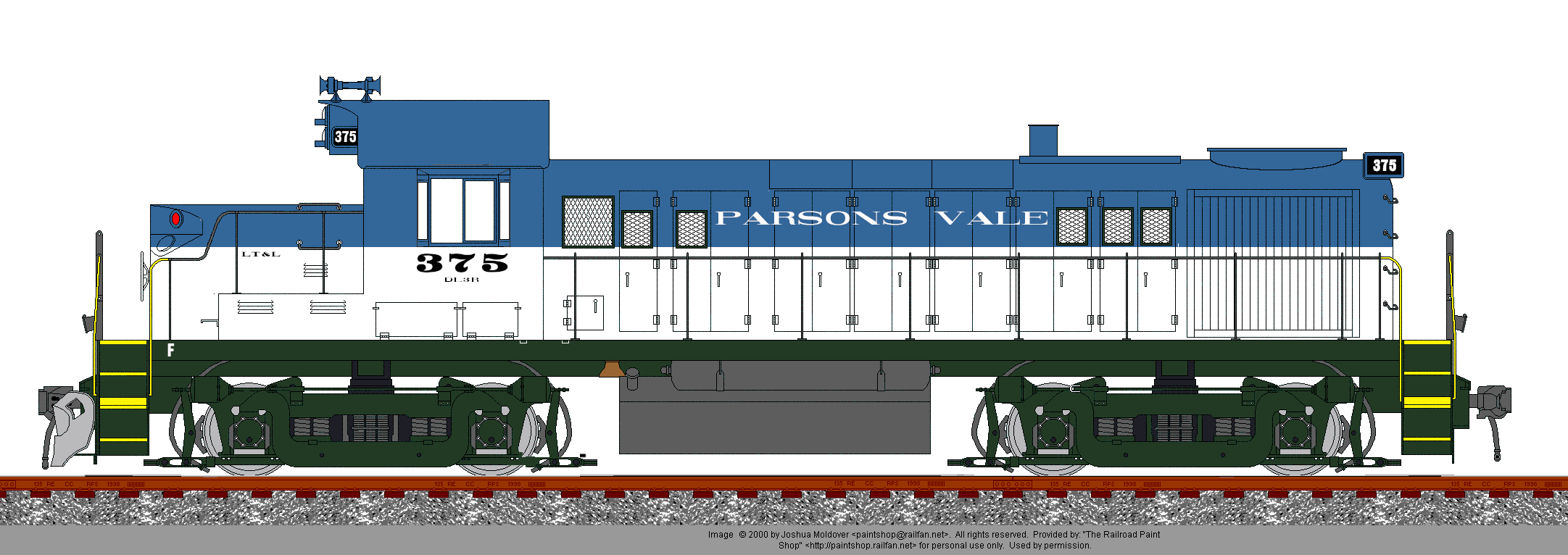
Template(s) drawn by Joshua Moldover, via The Railroad Paint Shop, and by myself, via my dining room table
PV&T #375 was the second of the two LT&L RS-2’s to be rebuilt with 251s in the MTRR’s Iberville shops, and by far the more successful one of the lot. Why so? You might think that the more conventional Alco-style cab & hood (like the rs-11/32/36 low hood units, if they were lightly squashed to fit) was the magic, but it was actually replacing the long hood with a century-style sealed engineroom that did the trick. #377 went back to the shops for a second complete rebuild 25 years later, but #375 continues to operate basically unmodified 55(!) years later.
—orc Sat Oct 30 00:40:49 2021
Oct 29, 2021

The artist at work!
—orc Fri Oct 29 23:52:14 2021

Template(s) drawn by Joshua Moldover, via The Railroad Paint Shop, and by myself, via my dining room table
This RS-2 was originially rebuilt with a GE Universal-style cab, low nose, and 251 in 1965. The cab did not meet with overwhelming approval from the LT&L & MTRR crews, so when it came due for a major overhaul in 1990 the MTRR shops decided to do a wheel-up rebuild, ending up with what you see here.
The 251 stayed, as did most of the electrical gear, but other than that it was quite a different story; Another GE-styled cab (all flat sheets welded together), but this was a wide-nosed cab like the c40-8w (turreted to fit on a rs-2 long hood) sound-isolated and huge for a more comfortable ride even on a train that required a 4-person crew, a new sealed long hood to keep the machine room cleaner, and this garish hi-visibility safety paint scheme. It’s now basically a M418, if such a thing existed, and it’s good for another 30 years of service.
—orc Fri Oct 29 21:10:14 2021
Oct 28, 2021

Template(s) drawn by Joshua Moldover, via The Railroad Paint Shop, and by myself, via my dining room table
MTRR #446 (BLWRS/BLW251/B11, depending on who you talk to) coupled to PV&T road slug #457. #446 was originally a MTRR Baldwin VO-660, #457 was originally a LT&L RS-1, but they don’t look much like they used to anymore. The blue dip paint job on #457 was because blue + white didn’t look right in mockups, but the curse of blue dip is that it makes the engines look like blueberry pudding, which isn’t a particularly great look for a locomotive.
—orc Thu Oct 28 14:00:25 2021
Oct 27, 2021

It turns out that leeks are hard to kill. I couple of batches of red beans & rice ago I saved the base of the leek so I could plant it (assuming that the squirrels would eat it, of course) and just the other day noticed that they had not.
—orc Wed Oct 27 17:15:48 2021
Oct 26, 2021

Template(s) drawn by Joshua Moldover, via The Railroad Paint Shop, and by myself, via my dining room table
The A trucks here are still good, so the shell of this locomotive (front of #215; the back end was in better shape and ended up as part of #220) is sitting on top of them to (partially) protect them from the weather. This is not by any means a functional locomotive – there is no wiring connecting the trucks to the bodyshell, so the electrical gear in the cab is just for show.
—orc Tue Oct 26 19:48:40 2021

Template(s) drawn by Joshua Moldover, via The Railroad Paint Shop, and by myself, via my dining room table
PV&T 319 (ex SLR 100) started out as an express motor, but by the time of the PV&T takeover was only being used as a MOW vehicle. With 500 HP, it could pick up and move a reasonable number of MOW cars down the line with enthusiasm, but wood. And link & pin couplers to match the MOW cars (all old trolley stock, cut down from motors & passenger cars) that the SLR used.
It already had the SLR logo painted out on the carbody sides, so painting over the old #100 with the new #319 was no problem, and that’s how it ran from 1950 ‘til 1958, when the third rail was turned off, 319 was loaded onto a flatcar, and then went up to Kennebunkport to join the Seashore Trolley Museum’s collection.
—orc Tue Oct 26 02:55:15 2021
Oct 25, 2021
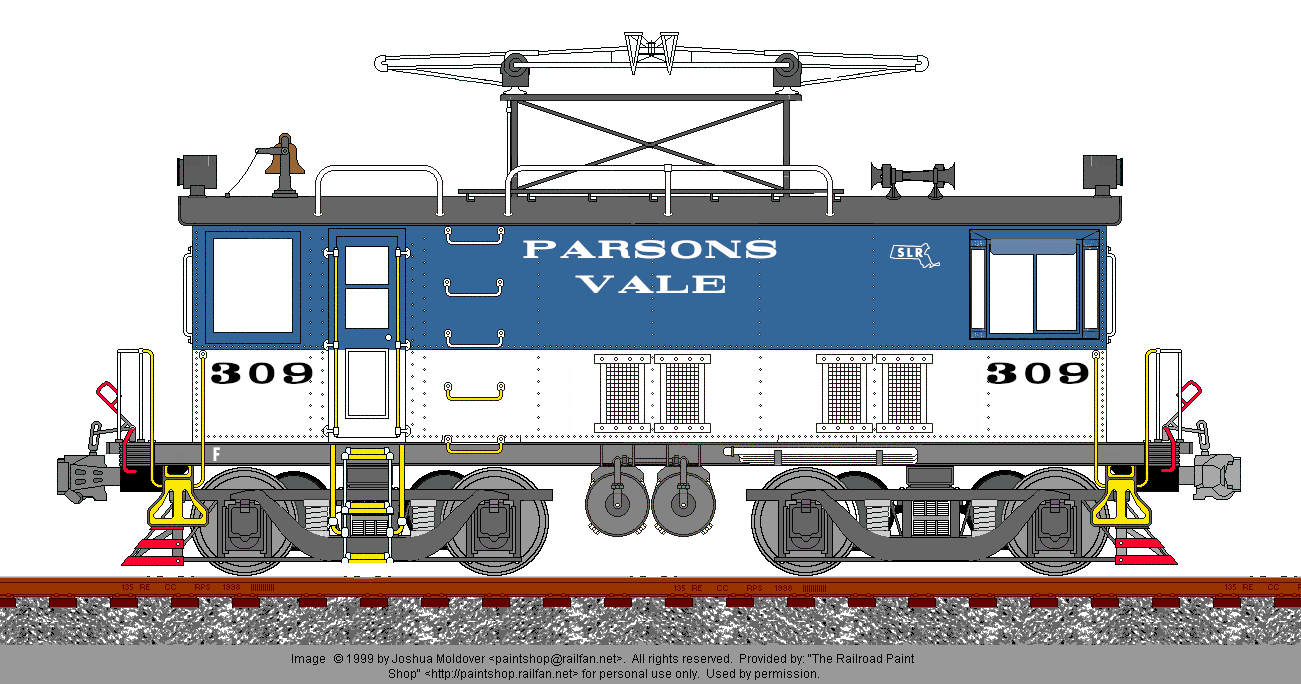
Template(s) drawn by Joshua Moldover, via The Railroad Paint Shop, and by myself, via my dining room table
Originally SLR 1000, this extraordinarily tiny boxcab is part of a class of locos tiny enough to fit onto Boston Elevated trackage (The SLR 1000s were designed to fit the Boston Elevated guage because both the Boston Elevated and the SLR thought that through running of parcel freight might happen, but it never did and the only time a 1000 ever ventured onto the elevated was to deliver mu cars.)
When the PV&T coverted the SLR to 3kvdc, most of the 1000s went to scrap, but the class engine instead went to the Portland shops and was rewired for 3kvdc, emerging like you see it here without 3rd rail shoes or a trolley pole, but with pilots attached to the trucks, corner steps, an all weather driver’s window, a pan (on a platform to reach uuuuuup to the PV&T height overhead), new roof-mounted lights, bell, and horns, and finally a spiffy blue & white paint scheme.
It’s /considerably/ less useful than the 320s that replaced all the other third rail units, but the tininess means it can work its way into sidings that a full-sized locomotive cannot.
—orc Mon Oct 25 23:03:36 2021
Oct 24, 2021

Template(s) drawn by Joshua Moldover, via The Railroad Paint Shop, and by myself, via my dining room table
A PV&T class 320 (GE E10B, 3kvdc variant) and 315 (Baldwin-Westinghouse “class B”) side by side on the SLR; the 320 is a new unit for the reelectrified railroad, and the 315 is one of the third rail units that had been running since the 1920s. They can’t actually share the line, because the reason that the SLR was reelectrified was that the PV&T thought that a maze of third rail industrial trackage was a horrible horrible disaster just waiting to happen.
None of the 315s made their way into preservation, at least not in 1958, because they found homes in the handful of freight interurbans that had survived the 1950s and weren’t coughing up blood like the CA&E and CNS&M (315 ended up on the Philadelphia & Western, close to where its carbody was built 37 years before.)
—orc Sun Oct 24 23:48:38 2021
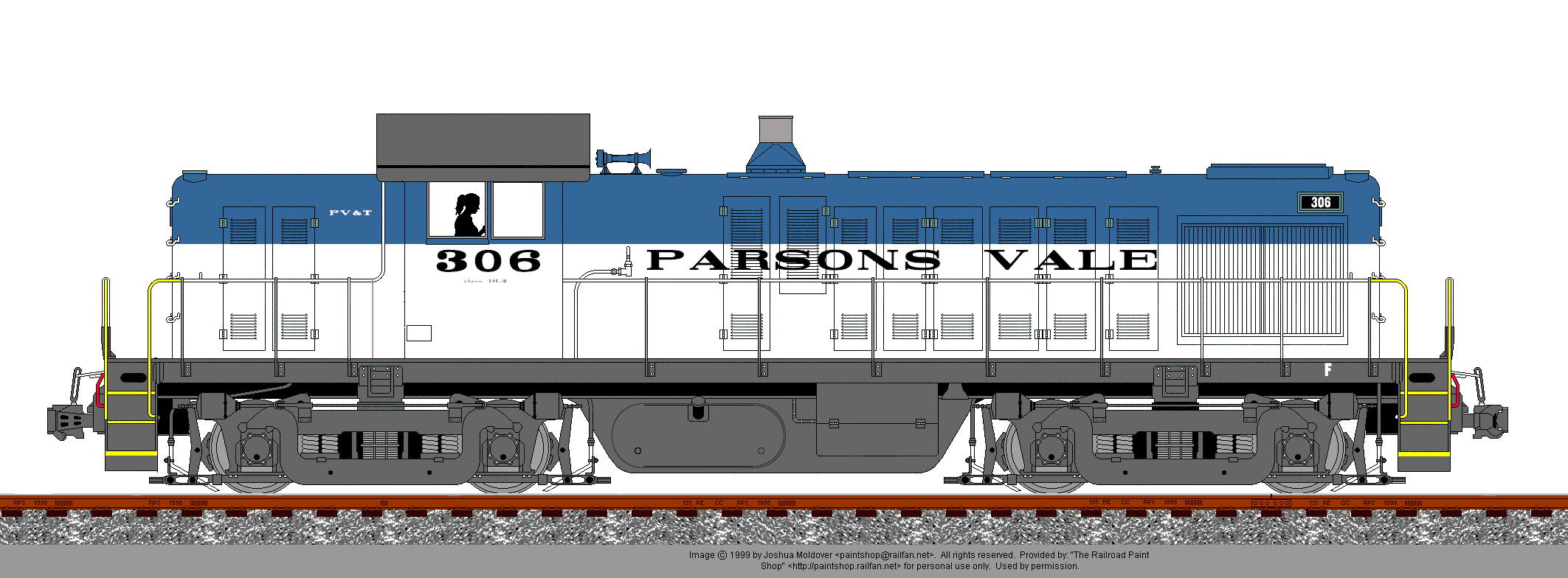
Template(s) drawn by Joshua Moldover, via The Railroad Paint Shop, and by myself, via my dining room table
But it’s the last OG PV&T RS-1 on the roster as of 1984, and it’s the last paintjob (and kitbash of railroad paint shop templates to make a 1:25 RS-1 from a 1:25 S2, a 1:25 RS-27, and a 1:25 F7) of a pre-1950 PV&T locomotive class (I need to do 3 SLR 3rd rail electrics, but that later!)
—orc Sun Oct 24 13:36:35 2021
Oct 23, 2021

Template(s) drawn by Joshua Moldover, via The Railroad Paint Shop, and by myself, via my dining room table
A recently retired class B1 (#220), a section of carbody + a center truck from another one (#215), plus a section of carbody & 2 center trucks from wrecked (in 1944) #221 == class B1x #220, with ~375 tons on drivers, 7800/10500 HP (4×450hp & 10×600 traction motors; continuous & 5 minute ratings), and approximately 1060 kN of tractive effort.
It was never fully painted, but spent its second career in half shop paint.
—orc Sat Oct 23 13:45:22 2021
Oct 22, 2021
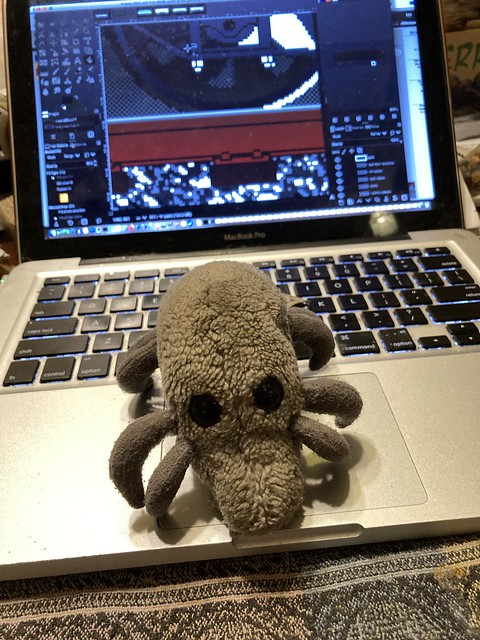
Dust Mite would like to remind you that today is Friday and there are certain routines that need to be observed before the clock strikes midnight!
—orc Fri Oct 22 23:48:19 2021

Template(s) drawn by Joshua Moldover, via The Railroad Paint Shop, and by myself, via my dining room table
PV&T #282, a fairly modified Baldwin-Westinghouse class B steeplecab, has bounced between 4 owners without going more than about 50 miles away from the carbarn at Parsons Vale at any time (except going to Portland to be rewired from 600vdc to 3kvdc) – originally LW&C #42, the (briefly) PV&T #282, then PVRT #980, then finally PV&T #282 again – and all while being assigned to various switching and local freight jobs on the splat of branchlines radiating out from the tiny little village of Parsons Vale.
Note that it’s sitting on huge trucks (8'6" wheelbase instead of 7") – that’s because the LW&C wanted larger traction motors and two brake cylinders on each truck, and those couldn’t be fit inside the frames of Baldwin’s standard class B MCB truck. It’s also got different windows (the PVRT cut out the old end windows and put bigger ones in, and the center window was replaced with a smaller one when the center section of the cabs were replaced during the conversion to 3000vdc. And the sand pipes are routed outside the frame, so that the driver can hop down and whack them with a broom if they freeze up in the middle of January (they allegedly are supposed to stay warmer inside the trucks, but the experience of other earlier power said that the lines would still freeze up and you’d have to start a small fire below the offending truck to thaw them out, which is a somewhat more involved outside activity that you might want to be doing in the White Mountains in the middle of winter.)
The script Rapid Transit on the cabsides is a PVRT thing, which is on the locomotive because this is the last surviving PVRT power on the PV&T and the MTRR’s eclectic paint philosophy is a bad influence across the entire railroad.
—orc Fri Oct 22 03:05:56 2021
Oct 20, 2021
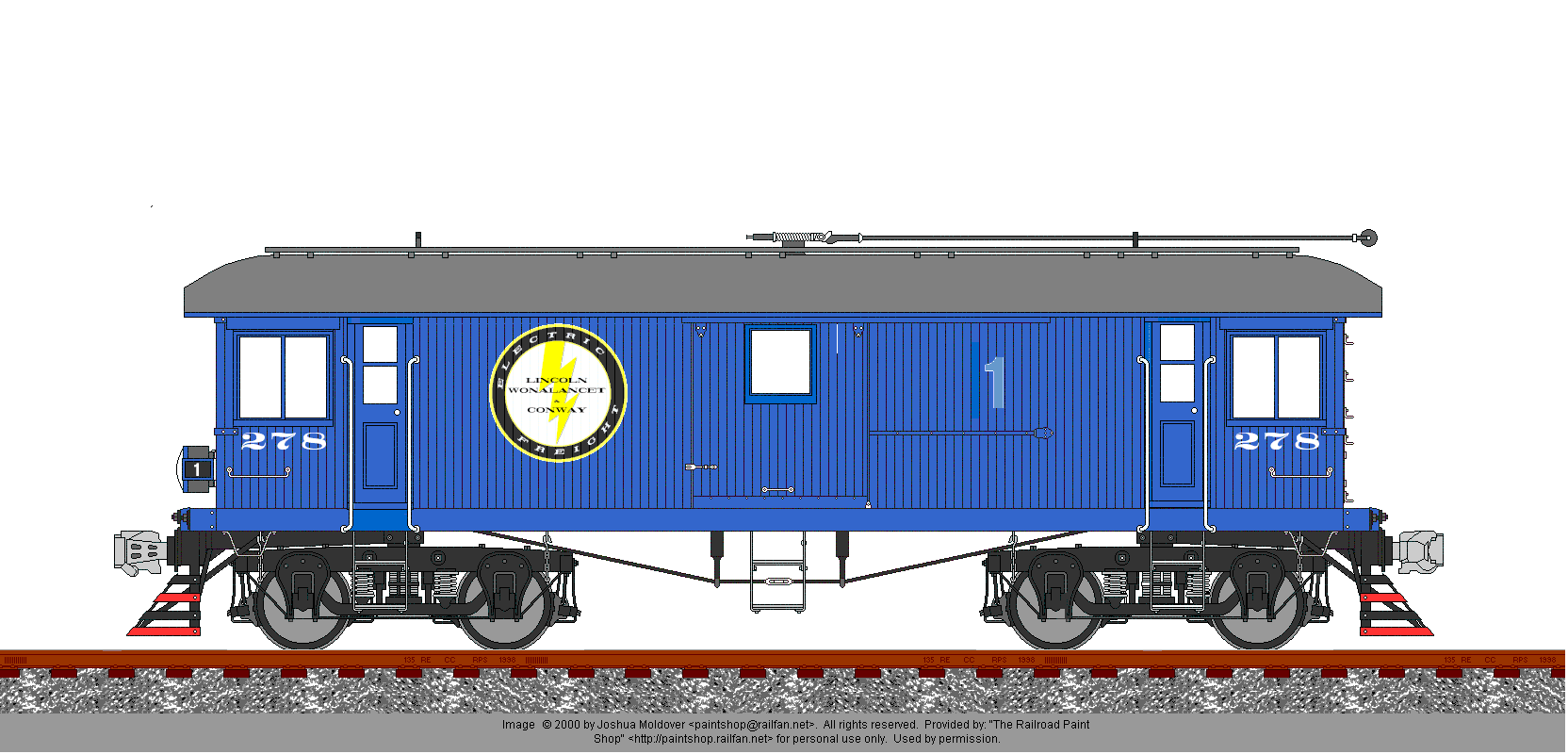
Template(s) drawn by Joshua Moldover, via The Railroad Paint Shop
This box motor (PV&T 278, ex LW&C 1) – an ~500hp 600vdc boxcab that last saw service in spring 1937 before the LW&C was powered off and updated to 3000vdc – only techically still exists as a workshop in a backyard in Lincoln, approximately 75 feet away from the rail line it once ran on. The vivid paint scheme shown here is only a memory; the LW&C, as befitting a marginal-to-failing interurban line, had a spectacular huge logo and a vivid blue paint scheme to represent health and efficiency (neither of which were much in evidence during its existence, but a scrappy garbage rat logo was, for some odd reason, not chosen) though the pilots (still attached!) still have some flakes of the old red/black paint on them.
The drawing here shows some of the unhappiness that the LW&C train crews had about the whole business of the LW&C failing, being grabbed by that other railroad, and being stripped for parts. The PV&T renumbered the LW&C Brills into the PV&T numbering scheme, wired the LW&C shop to put on the new numbers and paint over the old ones, and so they got this; a thin wash of blue over the big #1 on the sides, 278s under the cab windows, the #1 still on the headlight (trolley line, so removable headlight, but the LW&C had the vanity that each freight unit should have its own headline with road numbers on it) instead of being painted over, and of course the LW&C ELECTRIC FREIGHT logo stayed on the unit until the very end. There were no markings showing that this was a PV&T engine, and that’s the way the crews liked it!
—orc Wed Oct 20 23:28:17 2021
Oct 17, 2021
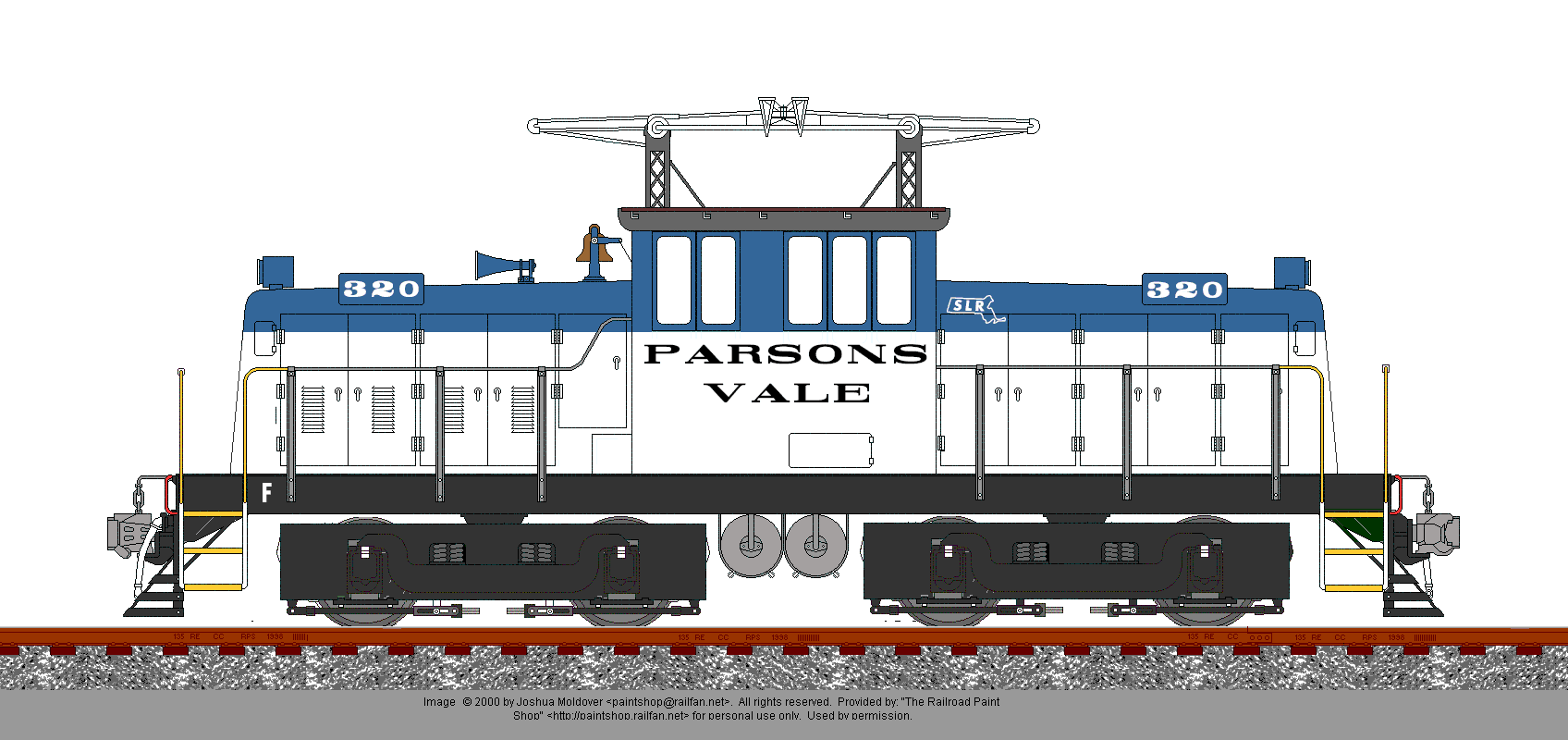
Template(s) drawn by Joshua Moldover, via The Railroad Paint Shop
The paintshop site, for some reason doesn’t have most of the locomotives that PV&T rosters (I’ve settled on 1:25 scale profiles, which cover some of the Alco models the PV&T runs, but none of the electrics) so I have to take existing profiles and kitbash the dickens out of them. This is getting to be a somewhat more involved process, like this approximation of the first of the E10B’s that were purchased when the SLR re-electrified from 600 to 3000vdc – this is very vaguely a modification of the 1:25 scale GE 44 ton locomotive (about all that’s left of that model are the couplers, coupler mounts, ladders, and horn.)
(Note the Milwaukee Road-style hoodside plates for the road numbers; there’s not really enough room on the blue-painted parts of the hoods for large numbers, so why not make my Milwaukee Roadish look EVEN MORE so?)
—orc Sun Oct 17 22:10:13 2021
Oct 15, 2021

Admiring a postcard of a first-generation Alco, as one does.
—orc Fri Oct 15 23:55:04 2021

Template(s) drawn by Joshua Moldover, via The Railroad Paint Shop
By the time 1980s rolled around the MTRR’s Iberville shops were starting to get a reputation for being able to rebuild old Alcos into the functional equivalent of what Alco might have been producing if not for being dead – not the high horsepower units that MLW was producing, but they’d take an old locomotive and update it to a suitably-sized 251ed machine with everything else reconditioned and updated to fit.
Which meant that when the shop crews had a wild idea for how to update a PV&T locomotive the rest of the maintenance department would just avert their eyes and leave them to it; in this case, crew complaints about the last two LT&L rs-1s had reached the point where the railroad needed to either retire the units or upgrade them to MLW-style wide-nosed safety/comfort cabs, and the shops expressed their extreme enthusiasm for the idea of doing the rebuild themselves.
So. A MLW rs-1 + the cab of Amtrak sdp40f #578 + some metalwork to fill in the length gap between a rs-1 cab + short hood and a sdp40f cab and #362 was good for another 40 years of service (still with the original 539 tuned up to a whopping 1100 HP for those branch line trains & switching jobs where too many HP was wasteful excess.)
—orc Fri Oct 15 19:34:44 2021
Oct 14, 2021

Template(s) drawn by Joshua Moldover) & Kelly Lynch, via The Railroad Paint Shop
276 (and its now-scrapped siblings 277 & 278) were built as B-(2?A)-B fell incline locomotives to supplement and eventually replace the steam units on the (max 1 in 10!) Mount Cube ramp. However, the PV&T purchased the B&M line from Plymouth to Wellsville when it was abandoned after WW2 and the fell incline was /immediately/ closed and dismantled, leaving this engine without a job, at least until the old Southern Vermont Traction line from Pownal to Arlington needed a dedicated locomotive.
So, after a quick tuneup (and removal of the unneeded Fell rail truck) and a coat of traction orange (there is street running through Bennington, but not much traffic to the north side of town now that the line to Arlington has been abandoned, so a somewhat more eyecatching paint scheme was needed) this one locomotive went off to Vermont to spend the next 50 or so years shuttling freight between Bennington & Pownal.
—orc Thu Oct 14 23:03:10 2021
Oct 11, 2021

Template(s) drawn by Joshua Moldover, via The Railroad Paint Shop
The first of the Budd cars that the PV&T bought in 1960 to try and keep some passenger traffic on the Portland to Montréal route (which sorta kinda worked; there were enough riders so it wasn’t a total embarrassment to the bottom line) and which became commuter cars (on the Boston-Lowell line) when Amtrak & VIA Rail Canada (the cars went north to the Montréal to Québec City route for the intervening 4 years) took over (pretty much) all the intercity passenger services in the United States & Canada.
Note the pilots; Budd would have been happy to put RDC-style pilots on these RDC-style interurban cars, but the PV&T preferred bar pilots and asked to have the cars delivered w/o pilots so the Portland shops could fit them out with PV&T-standard ones.
—orc Mon Oct 11 19:37:37 2021
Oct 10, 2021

Template(s) drawn by Joshua Moldover, via The Railroad Paint Shop
There is no prototype that’s very much like the PV&T’s class A locomotive (the NYC Ra is close, but it was built over a decade later) so I collaged a fistful of Joshua Moldover’s templates (Alco S1, NYC T, Milw EF-1, Lima LS-1000, EMD F7, an open platform combine, and a PRR DD-1)into this mockup of the original GE class A locomotives that the PV&T purchased to electrify the northern Vermont subdivision & the west side of the Mount Cube ramp (the east side was the Fell incline, of course, and that electrification was still 15 years down the line.)
These are tiny locomotives; they are heavy interurban boxcabs (so if the PV&T electrification failed they could be sold to trolley lines and some of the expense could be recouped) and the design was not repeated when the PV&T & GE designed the class B, but 5 of them were still in service 72 years later (2 of those were assigned to the ex-LW&C, 2 were on the PVRT, and 201 had spent 45 years as a dedicated wire train locomotive after being taken out of mainline service in 1939.)
These locomotives have been extensively rebuilt several times in their lives; the original electrification was @ 2.4kvdc to be compatible with the Canadian Northern’s Montreal-area electrification, but the PV&T decided that a 3kvdc electrification was a better bet when the Green Mountain subdivision was wired, so they were rebuilt to handle that tension, and immediately after the second world war they had a major traction upgrade that took them from 750 HP to 1200 (1320 hourly.)
(edit: replaced the drawing with one that shows 201 & 204 in both the paint schemes these locomotives have worn.)
—orc Sun Oct 10 02:36:52 2021
Oct 08, 2021

A mite infestation in a catproof bouquet.
—orc Fri Oct 8 23:59:47 2021

Template(s) drawn by Joshua Moldover, via The Railroad Paint Shop
By the 1960s the PV&T’s venerable class B locomotives were starting to get a little long in the tooth, so the Portland shops pulled two idled B1s units (238,239) out of the storage yard and remanufactured them as road units with the latest technology (at least the latest technology that the engineering department thought would be reliable enough to replace the almost 50 year old technology that the class Bs were based on) and, partially for safety reasons, partially for looks, a pair of streamlined cabs that looked like the upper 7/8ths of F7 cabs.
And so, the class B4 (aka class E) high horsepower road locomotive; rated at 6100 continuous HP (~8000 5 minute rating, ~7050 hour rating) and with enough tractive effort to run a 40 car train over the Green Mountain subdivision at track speed (instead of mountain climbing speed on this 60 miles of mountain railroad with grades up to 2%)
Looking like the offspring from a unholy union between a Little Joe & an EF-1 doesn’t hurt, either.
—orc Fri Oct 8 19:47:17 2021
Oct 07, 2021


Every year we discover /another/ weird trick some previous homeowner did to our poor house. Monday’s discovery was that the cold water feedpipe to the kitchen sink hadn’t been properly taped, so 20+ years of galvanic corrosion between the copper shutoff valve & cast iron pipe had converted the end of the pipe into a block of solid rust. I discovered this when I pulled the spray hose too vigorously after it had – unbeknownst to me! – gotten wrapped around the shutoff valve, and the goddamn thing just snapped off the feed line.
After a few exciting minutes running around trying to find the water shutoff valve (at 6am, without my morning tea!) and eventually turning the water off at the meter, I got the water turned off, the basement pumped out (it’s AMAZING how fast water fills a basement when it’s backed up by 600 feet of head) and could start working on patching our water supply so we’d have most of our water until we hire a professional to rip out all of the goddamn festival of plumbing kludges and replace it with copper and/or plastic pipe..
So behold the kludge de jour; I put a shutoff valve onto the cold water feed running to the kitchen/outside tap/clotheswasher/disgusting basement sink junction, then cut out the pipe running to the kitchen (filling the stub of the copper segment going that direction with epoxy, then crimping the end of the pipe so that water pressure won’t blow the epoxy plug loose) and dismantled the line going to the disgusting basement sink, replacing it with a hanging stub to connect the cold water to the clotheswasher.
The twine? That’s structural; the old plumbing was just hanging off the wall, held into place by the fittings on the disgusting basement sink, the outside tap, and the line up to the kitchen, so I had to make up for removing two of those connections by tying the cold water patches to the (unsupported except for the disgusting basement sink fittings) hot water line.
(It’s a disgusting basement sink because there’s a tangled junction of sewer pipes just below where the sink drain connects to the sewer, so if the waste is ever /chunky/ it tends to jam at that intersection and backwash into the sink.)
—orc Thu Oct 7 16:44:20 2021
Oct 06, 2021

Template drawn by Joshua Moldover, via The Railroad Paint Shop
75% of the DL109s in the world (GM&O 291 is sitting in the IRM, safely away from the breaker’s yard after Alco was shutdown and dispersed their (small) historic fleet in 1970) freshly washed and ready to pull a fantrip from Montreal to Albany on the ex-D&H Lake Champlain main.
—orc Wed Oct 6 19:06:52 2021
Oct 05, 2021

Template drawn by Joshua Moldover, via The Railroad Paint Shop
Penn Central would have scrapped it, but the staff at MTRR’s Iberville shops had a better deal for the unit. Which invovesd a pair of 251B-8 engines, a new set of traction motors & generators, a completely new electronics cabinet, and all this topped off by a New Haven homage paint scheme.
This gives the MTRR – after Milw #1 was acquired and rebuilt in 1981 – a fleet of 3 cranberry locomotives, as well as giving the PV&T 3 of the 4 surviving DL109s.
—orc Tue Oct 5 16:38:12 2021
Oct 04, 2021

Template drawn by Joshua Moldover, via The Railroad Paint Shop
Ex-CMStP&P FP45 #1, now (after a detour through the breaker’s yard, and then the MTRR shops for a new generator/prime mover/electrics) PV&T DL12 #462 – basically a cowled C636 with flexicoil trucks – acting as an evaluation for a never-to-be-realized order of M636s.
As Milwaukee #1 it had an electrical cabinet fire, and as part of replacing it the carbody was modified to include a pair of machinery doors; when the engine was replaced with a 251-20 the roof panels above it was replaced with one that had no air filters or fans, then a row of portholes were dropped in to get some light onto the engine compartment to make the machine room a little less of a horrible dark cave.
Painted cranberry orange to make it stand out as a test platform, which wasn’t really necessary because an EMD sounding like an Alco is headturning enough!
(it was a successful test platform, but the PV&T’s considered purchase of a handful of M636s was mooted by the D&H merger, which dumped enough non-251'ed power into the diesel division to make it less important that everything diesel also have a 251 or 239 as a prime mover.)
—orc Mon Oct 4 00:59:31 2021
Oct 03, 2021

Template drawn by Joshua Moldover, via The Railroad Paint Shop
A much much more complex and fiddly scheme which probably takes almost a week to apply. Very pretty, but for passenger service only (and then only on locomotive-hauled trains; commuter trains & the long-haul trains that were held down by interurban cars used either a stainless + blue or the freight white + blue scheme.)
—orc Sun Oct 3 14:51:32 2021
Oct 02, 2021
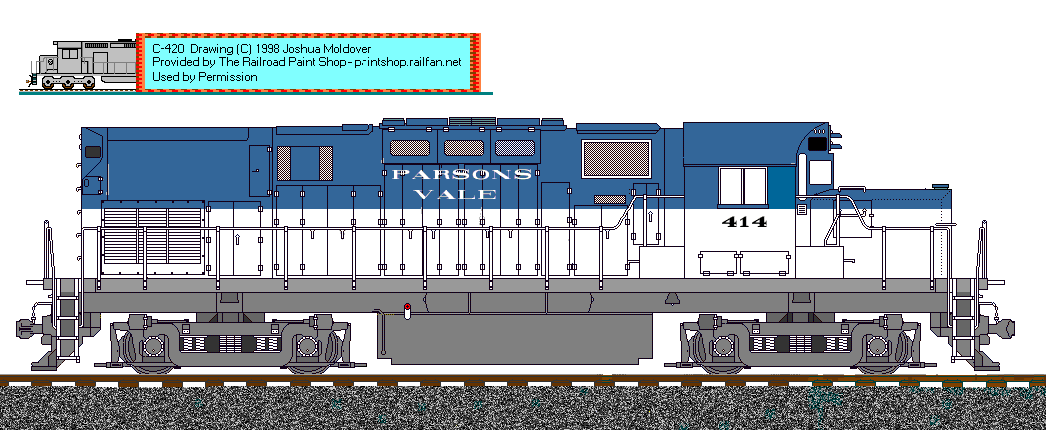
Template drawn by Joshua Moldover, via The Railroad Paint Shop
The first of the 1963 c420 order wearing the 1960s version of the traditional PV&T white + Big Sky Blue (the color capture isn’t quite bsb, but is close enough for this image) paint scheme. (The earlier version of the white+blue scheme put the PARSONS VALE onto the white band, but the failed blue dip paint scheme had white text on blue, which was kept after that scheme was abandoned.)
—orc Sat Oct 2 19:01:53 2021

Template drawn by Jacques Belangér, via The Railroad Paint Shop
Why should the Great Northern have all the fun with orange & so-dark-it’s-almost-black green?
When the diesels started to arrive on the MTRR in the mid-1940s (LT&L & PV&T units for switching & yard service) the GN had already gotten their lovely orange+green+gold FTs and, in the grand tradition of railroads everywhere, the MTRR decided that imitation was the best form of flattery. Not an exact imitation – complex paint jobs cost money & time, so gold pinstriping and a fancy star design on the hood ends were right out, and too many stripes start to collide with the railroad name on the hoods – but the colors & top band height were copied directly over.
This RS-2 was originally LT&L 513, but was renumbered to 371 after the 1961 PV&T+LT&L+MTRR merger. The MTRR was very resistant to the idea of repainting in the PV&T’s blue+white scheme (the LT&L had adopted that scheme years before, so didn’t care) so this unit never got painted out of the MTRR name & colors before the great 244 purge of the late 1960s swept it out of the roster.
(Over the long term the MTRR’s insistence on retaining their own paint scheme won; by the late 1970s, it was official railroad policy that subsidiaries & divisions would be allowed to preserve their original paint schemes or simplifications thereof, and by the time the D&H was merged there were a dozen or so new MTRR diesels operating in the orange+green paint scheme.)
—orc Sat Oct 2 14:48:56 2021

Template drawn by Joshua Moldover, via The Railroad Paint Shop
The D&H’s C424m’s make a good test frame for paint scheme experiments, because they were delivered in a boring as paint solid blue dip (the PV&T experimented with the solid blue dip too, but rejected it because (a) boring as paint and (b) it looked awful when it got dirty.
The D&H is an ancient railroad – much older that the PV&T – and it didn’t seem proper to just submerge the company under the standard PV&T colors. So this variant (on the c424m class leader) – dark blue on top of white, with a yellow band replacing the lightning stripe and the unit number relocated to above the radiators so a standard D&H shield can go under the cab windows. (The yellow band straddles the lower frame of the cab windows instead of the PV&T’s Big Sky Blue starting at the top of the lower frame.)
This scheme is growing on me; it’s definitely a PV&T scheme, but it’s not, so it won’t violently clash with the OG Alcos of the PV&T/LT&L/MTRR, but is still definitely not one of the three railroads that made up the Parsons Vale between Dec 3, 1961 & Jan 4, 1984.
—orc Sat Oct 2 02:05:24 2021
Oct 01, 2021
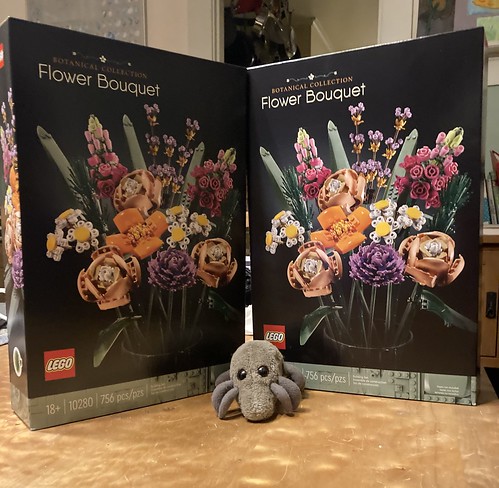
Lego birthday flowers; they won’t wilt and the cats will have to try really hard to kill themselves by eating them!
—orc Fri Oct 1 23:51:14 2021
—30—



































